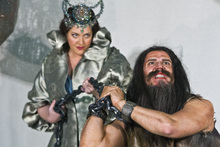This is an archived article that was published on sltrib.com in 2013, and information in the article may be outdated. It is provided only for personal research purposes and may not be reprinted.
Utah Opera is opening its season this weekend with opera's most perverse love story.
Renovations at the company's usual home, the Capitol Theatre, necessitated a move to Abravanel Hall for the opening production. Rather than being a handicap, the move freed the company to stage Richard Strauss' "Salome," an opera that requires musical forces too big for the Capitol Theatre's pit. (An expansion of that pit, by the way, is one of the items on the renovation agenda.) This biblically proportioned story of corruption, lust and depravity is right at home in Abravanel, whose seating capacity is roughly 150 percent of the Capitol's.
Placing the Utah Symphony onstage with the singers seems fitting, as Strauss gave the orchestra such a prominent role. Under Stewart Robertson's direction, the orchestra turned in a powerful and passionate performance of Strauss' absolutely delicious score on Friday. There were times when it was all the singers could do to hold their own, but that's what supertitles are for, right? (That said, the lighting often made the titles, projected on two screens above the stage, difficult to read.)
Soprano Marcy Stonikas was riveting as Salome, the Judean princess with an outsize sense of entitlement. She navigated the demanding role with confidence. Baritone Michael Chioldi brought palpable charisma to the role of the unfortunate object of her affections, John the Baptist (called Jochanaan in the Oscar Wilde play on which Strauss based his opera). Another savvy staging decision was placing the prophet's underground prison onstage and showing him in silhouette. This also ramped up the tension in the execution scene considerably.
Tenor Jon Fredric West as Salome's lecherous stepfather/uncle, Herod; mezzo Victoria Livengood as her mother, Herodias; and tenor Robert Breault as Narraboth, the lovestruck captain of Herod's guard, also turned in outstanding performances. They were supported by a strong cast of Jews, Nazarenes and palace staff.
Director Kevin Newbury collaborated with set and costume designer Vita Tzykun on the production's visually arresting design, which made prominent use of the moon and other celestial bodies. Of Tzykun's stunningly stylized costumes, Salome's fabulous cloak, glittering with Swarovski crystals, was of particular note.
Rather than stage the notorious Dance of the Seven Veils as a striptease, Newbury has chosen a symbolic interpretation that plays on the association between Salome and the moon. Choreography is minimal, which is fitting in a way because this dance is as much the orchestra's as it is Salome's. Still, a little more movement wouldn't have hurt.
Stonikas, rock-solid all evening, outdid herself in the opera's closing aria, in which Salome passionately declares her love to the Baptist's severed head. It's a chilling scene that viewers won't soon forget.
Heads up
Utah Opera presents Richard Strauss' "Salome."
When • Reviewed Friday, Oct. 18; repeats Sunday, Oct. 20, at 2 p.m.
Where • Abravanel Hall, 123 W. South Temple, Salt Lake City.
Running time • Just under 2 hours; no intermission.
Tickets • $18 to $95 with various discounts available; http://www.utahopera.org.
In a nutshell • Salome, a spoiled teenage princess in the court of the degenerate Herod, takes an unhealthy interest in the imprisoned John the Baptist.
Learn more • Principal coach Carol Anderson will give a preview lecture an hour before curtain; the company's artistic director, Christopher McBeth, will lead a Q&A after the performance. Both events take place in Abravanel Hall's First Tier Room.



